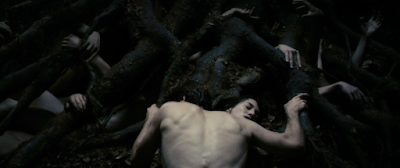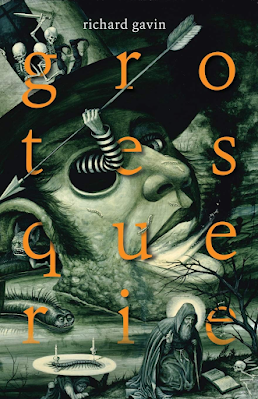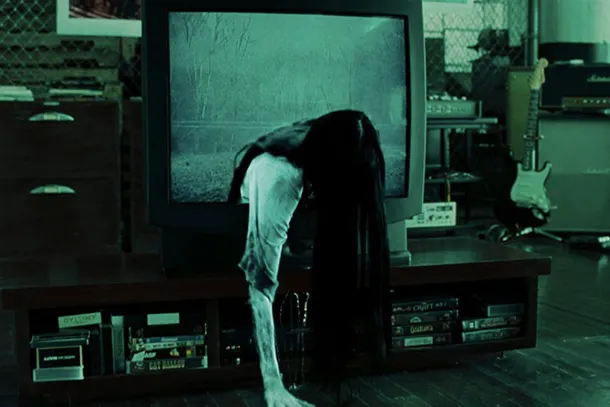If we are to believe its director, the 2009 horror film Antichrist arose from the heavy miasma of a profound, debilitating depression. “There was no pleasure in doing this film,” he admits in an interview shortly following the film’s scandalous debut at Cannes. He speaks of having to force himself to write ten pages every day just to complete the project, of filming at half his ordinary capacity, of the whole experience being “a kind of hell”. And yet, he insists, the film is by far his “most important”, “made from what I would call a pure heart”. The apparent significance of this deeply personal background for him encourages an understanding of the film as atypically candid, indeed as confessional, as, in a word, honest.
Of course, there has long been a widespread, not entirely unjustified reluctance to take Lars von Trier at his word. His nearly thirty-year reputation as, variously, malevolent prankster, canny showman, sadistic misogynist, wannabe Nazi, visionary genius, shallow provocateur, and above all else—in an endlessly, tediously re-invoked cliché—cinematic “enfant terrible” has more than invited a certain degree of skepticism (to say the very least) as regards his intentions and means of achieving them. Antichrist has stoked this sort of controversy perhaps more than any of his other films. Featuring (we may as well get these things out of the way now) an infamous CGI fox who intones pronouncements of doom, explicit shots of unsimulated penetration and fake blood spurting out of a cock, and, of course, what else, that ghastly, wince-inducing close-up of a self-performed clitorectomy responsible for one of the most stunned silences in Cannes history, the film offers a veritable buffet of what many consider to be the very worst tendencies in von Trier’s filmography. Moreover, the central thematic strand of Antichrist’s second-half—an eyebrow-raising evocation of the age-old association between the feminine and the Satanic—openly courts the accusations of misogyny that have dogged von Trier since his 1996 melodrama Breaking the Waves. Was this not yet another cynical charade, a calculated provocation, even, to quote British TERF Julie Bindel, “the sickest general release in the history of cinema”?
Well. Without personally offering an overall verdict on von Trier in general—an issue on which, both as a great admirer of his movies and an individual troubled by his worst behaviors and tendencies, I remain as divided as anyone else—I would like to venture that, at least with this film, he has been almost totally sincere. There’s no doubt the man is a troll, and even Antichrist is laced with a tremendous amount of sneering irony and black humor, but watching the film, his insistence that it was created in a place of genuine suffering and apathy rings true. For better or worse, the fogginess of Antichrist’s narrative, its ambiguous characterizations and sometimes inscrutable abstractions, the knotty tangle of troubling themes, repulsive imagery, and leaden, joyless despair with which every moment is weighted: all resonate with the absolutely draining and abject experience of serious depression, regardless of whether it makes compelling viewing or not. And feminist or anti-feminist, it’s fairly obvious that the mingled anxiety about and fascination with female sexuality and violence against women on display here is clearly something extremely personal to von Trier. Antichrist is one big, disgusting, indigestible outpouring of its filmmaker’s many hang-ups and neuroses, so naked and unprocessed that it’s almost unintelligible: and consequently, depending on your personal position, is either intolerable or utterly fascinating.

For a tale so steeped in ugliness, the film opens with an astonishing flourish of visual beauty. Like its sister sequence in the subsequent Melancholia, the prologue to Antichrist presents a painstaking sequence of slow-motion images that evoke, to borrow a phrase from critic Michael Sicinski, “the exquisite, agonizing beauty of stasis”. Facing each other in the shower, the all-too self-consciously archetypal She (Charlotte Gainsbourg) and He (Willem Dafoe) initiate a frenzy of copulation drained of its delirium by the solemnity with which it is shot. The molasses-slow movements and luminous black-and-white simultaneously evoke a sort of sustained paradisiacal ecstasy and an atmosphere of morbid, icy decay, nowhere more apparent than in the close-ups of Gainsbourg, whose wracked expressions convey a marked ambiguity between pleasure and pain. The couple fucks in a matrix of water and snow, the various scenographic accouterments (first a heater, then a washing machine, further on a tumbling glass bottle) acquiring a slightly absurd tinge as the sequence progresses. These devices serve a twofold purpose: to conjure an almost tongue-in-cheek atmosphere of soon-to-be-broken cosmic harmony, and to succinctly establish the domestic sphere which will prove to serve as the locus of horror and cruelty.
As He and She tumble from room to room, their erotic bliss seemingly unbound by rules of spatial consistency, their toddler Nic (Storm Acheche Sahlstrøm) wanders from his pen, observing his parents’ copulation with an unsettlingly wry smile on his face. Shortly thereafter he is standing before the bright open window, seemingly drawn forward by flakes drifted in from the wind; inevitably, he slips and falls, his terminal drop intercut with a close-up of his mother as her head kicks back in orgasm. The body hits the pavement, kicking up a funereal cloud of snow; her eyes gleam in release; the washing machine’s cycle finishes, signaling the end of this exquisite aestheticism and expelling us into the horrors of the narrative proper.
What does this alluring, impossibly macabre opening offer us? Grief, yes (probably the defining element Antichrist’s many “elevated horror” descendants have borrowed from it), but also the seductive danger of the natural world, the erotic thrill of death, and a perverse portrait of the nuclear family. There is, moreover, a gruesomely literalized allusion to the Biblical Fall of Man: and in Nic himself, one might well perceive the Antichrist of the movie’s title, an innocent son whose death brings about utter damnation and disaster instead of salvation.
These five strands—grief, nature, sex, gender, and religion—become intertwined in maddeningly complicated and often outright baffling ways throughout the subsequent scenes. It’s this murky, portentous meshing of unpleasant themes and ideas (which, I maintain, rings true to the muddled, gloomy mindset induced by depression) that has led some to dismiss Antichrist as incoherent. But to search for one clear throughline or allegory here is a mistake. Antichrist is instead a remarkably open and wide-ranging text, untied to any one single narrative or thematic strain: a horror movie whose simple set-up allows its filmmaker to hold a nightmarish mirror up to all manner of cultural myth-making surrounding human relationships and our place in the world.

Take the words of the aforementioned talking fox as its basic thesis. “Chaos reigns,” it tells Dafoe, who has happened upon it consuming its own entrails. It’s the ultimate image of the film’s understanding of nature: a sadomasochistic hellscape ruled by a suicidal law of self-cannibalization. von Trier drives home this idea repeatedly in some of the most unsettling images in his entire oeuvre. There is the fawn with a stillborn fetus dangling from its sex, the baby bird that tumbles out of a nest only to be swarmed by ants, the acorns that ceaselessly fall on the roof of the cabin in an eerie echo of Nic’s death. “Now I heard what I couldn’t hear before,” says She of their pitiless nocturnal rhythm. “The cry of all the things that are to die.” Contrary to its (increasingly dwindling) popular conception as a self-sustaining ecosystem, nature in Antichrist is bent on a perpetual destruction that turns ever more inward, devouring its young, mutilating itself. It’s a law the characters themselves will eventually internalize as their sex grows more brutal and their acts more violent: a backdrop against which the gruesome destruction of their genitals, organs of pleasure and propagation, seems an almost obvious final consequence of a world in which birth only means death.
He seems to be disturbed less by the fox’s unnatural capacity for speech and more by the import of his words. He is, after all, a psychologist, a rationalist, a bastion of civilization in the primeval hell he has confidently taken his wife to. But just what civilization, what rational order is he working to defend? We see glimpses in the film’s opening act, before the couple arrives in the woodland that will prove the site of their annihilation. Taking his wife out of the care of medical professionals (a scene punctuated by a telling close-up of severed plant roots in a vase of water), arrogantly confident in his own ability to treat her without medication, we observe the mechanics of a callous and heartless oppression masquerading as marital love and care. During one of her early panic attacks, when she fumbles for sex in an attempt to escape her terror, he pushes her away, then clamps his hand over her mouth and places his heavy thigh over her stomach. His words are in the soothing, even tone of a therapist, but his body language emphasizes a violent domination. The implication is even more explicit in the sequence following her halfhearted suicide attempt over a toilet bowl, following which he drags her away and immediately starts fucking her on their bed, a cruel reversal of her desire in the preceding scene, and a contemporary resurrection of the horrific psychiatric history of inducing orgasms in mentally ill or “hysterical” women. Wheezing in agony, she vanishes beneath his heavy body, his pale buttocks thrusting into her in as unpleasant a depiction of heterosexual intercourse as I’ve yet seen in cinema.
The cruelty is not only physical but psychological. Repressing his own grief—we only see it visibly once, in the tears on his face at the funeral—he trivializes his wife’s by treating it in the cold, impersonal language of a scientist. She observes, in one of the film’s more melodramatic sequences, that he has only ever interested her as a specimen, that he is indifferent to his child’s death. He doesn’t respond to these provocations, his face composed and impassive, masking his feelings with a supposed neutrality that, in truth, is simple inhumanity. To cap it off, in a remark that seems to have been the most personally hurtful to her, She accuses him of having said, or at least implied, that the subject of her abandoned thesis was “glib”. Though he denies the accusation and the question is never returned to, his indifference and dismissal will give rise to his own undoing.

The subject of that thesis, which we don’t find out until a marvelously-constructed “discovery in the attic” sequence in the third chapter, lays bare what is really at stake in his conception of civilization. The “civilizing”, “rationalizing” arrogance of patriarchal society has resulted in nothing but mounds of murdered women: a legacy documented in the innumerable woodcuts of witch burnings pasted all over her research space, and summed up by She in the simple, awful word gynocide. It becomes clear that He is a mere contemporary extension of this order, one which violently subjugates women to their role as wives and mothers and exterminates any deviation. The domestic paradise of the prologue becomes loaded with sinister meanings, an entire machinery of oppression manifested in the banal appliances of the household. We understand that She has lived with an awareness of, and possibly experienced (if only psychologically), the violence of this tradition long before her son’s birth. She is afraid of her husband—an abject terror hauntingly expressed in the film’s most iconic image, when He and She have sex at the base of a tree whose roots intertwine with pale, cadaverous hands. Here is the most succinct and searing illustration of the film’s understanding of the heterosexual relationship under patriarchy: it is to be fucked atop a mountain of corpses. And if her response is madness, is the deformation and possible murder of her child, it is only a product of the impossible double-bind between her existence as an individual (who loves and truly grieves her son) and her existence as “Woman” (with the consequent awareness of both her son and her husband as emblems of the patriarchal regime that tortures her). Torn between guilt, desire, rage, and fear, it is no wonder (by allegorical logic, anyway) that she ultimately self-destructs and conforms to history’s ghastly portrait of femininity, a hysterical, murderous witch who enacts a sexual terrorism upon the illusory order of Man.
It’s a doomed endeavor, of course. At the climax of the film, He overcomes his pain and strangles her against the wall of the cabin. The outcome is obvious from the moment he wraps his hands against her neck, and after only a brief, bitter struggle, She is finished. Watching this scene with a group, I was horrified to hear one of my male friends sighing with relief. It would seem that, by appealing to the outrageous, cartoonish violence of misogynistic stereotypes, von Trier has successfully created a scenario that can bait a male audience member into cheering on the murder of a woman. It’s a trap, of course. For what we witness is not so much the victory of one man over the forces that would destroy him as the brutal, barbaric reassertion of a rule infinitely more destructive and evil than anything She could manage individually. He burns her corpse like a witch’s on a stake, and the earth dissolves to reveal a multitude of naked bodies beneath the soil, the victims of a trans-historical campaign of murder in which She is now only one inconsequential chapter. The epilogue returns to the glowing black-and-white of the prologue, finding the man picking berries at the top of a great hill, feeding off the nature he strives to destroy. But his security is offset by what is the perhaps most intensely surreal stroke in a film full of them: the sight of thousands of faceless women, approaching from all sides, converging upon him. They are the manifestation of the sorrow, the pain, the fury of the many millions of women subjected to the brutal dominance of male hegemony over the centuries. It’s an image that’s terrifying, overpoweringly emotional, and weirdly funny in equal measure, a perfect summation of the film’s bizarre tonal contortions as well as its thematic concerns.
Against my better judgment, I have attempted to extract one possible reading of Antichrist in this piece. But I wish to stress how much of this film eludes my language—a difficulty that should be clear given how much of it I haven’t talked about—and how little it can be domesticated into a clear-cut metaphor for one thing or the other (least of all a cogent commentary on gender relations!). Most of its strength derives from its lack of clarity, its unpredictable digressions, and the troubling sense that it may be leading us toward some very dark territories indeed. Are we seriously being asked to contemplate the idea that female sexuality is evil? That nature itself is evil? That men and women are locked in an eternal, foredoomed battle? You could think about these questions for hours if you’re so inclined, and they certainly represent some of the more complex territory horror films are capable of exploring (though they’re usually all too reticent to: those descendants I mentioned earlier mostly lack even a fraction of this film’s bravery and weirdness), besides simply being part and parcel of the guaranteed Lars provocation package. But they’re ultimately less important than the rattle of those acorns on the roof, the fog that rolls across the dirt, the gothic glow of the camerawork, the morbid intensity of both Gainsbourg and Dafoe as they each move toward a confrontation with their worst selves. Fittingly for a project conceived out of depression, Antichrist first and foremost functions as an emotional (and sickeningly visceral) experience rather than one to be definitively understood or broken down. By that metric, it is one of the most remarkably effective and profound horror films I’ve ever seen.
Stepping back from all of the analyses, I’m attracted to the simplicity of Roger Ebert’s enthusiastic response, a response that hinged upon the simple idea, scrapped from von Trier’s original screenplay, of an earth created by the Devil instead of God. It is a “mirror world”, a world in which everything is wrong. A paradise that is hell. Sex that births death. Nature that destroys. Love that is hate. A lonely, disordered wasteland of pain, marked solely by agony and futility, through which Man and Woman wander burdened by the damnation of their knowledge, one an impotent monster of unfeeling sterility, the other a nightmarish wellspring of frenzied sexuality and despair. Trapped forever in the torment of their accursed Eden: a new creation myth for Satan’s church.














